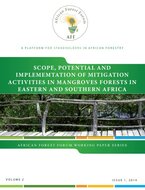Reduced Emissions from Deforestation and Degradation, plus the role of conservation, SFM, and forest carbon stock enhancement (REDD+) is a policy initiative developed by the international community to counteract the loss of forests and to provide incentives against deforestation in developing countries. With this new international mandate to tackle deforestation and forest degradation, this report was developed for the African Forest Forum (AFF) African forests, people and climate change project to evaluate the scope, potential and implementation of mitigation activities in mangrove forests in Eastern and Southern Africa. It was considered important to contribute to the understanding of the role of mangrove carbon credits to the livelihood of local communities and to sustain biodiversity and improve the quality of the environment. This also led to recommendations for furthers studies and formulation of REDD+ policies and programmes aiming at increasing equity and enhancing carbon stock in mangrove forests.
The study revealed that REDD+ activities implemented in mangrove forests in Kenya and Tanzania were basically readiness and demonstration. These activities were implemented at all levels and they were not specific to mangrove forests. Various institutional arrangements were established at all levels to provide enabling environments for implementation of REDD+ activities in mangrove forests. Mikoko Pamoja and Hifadhi Misitu ya Asili were the only two active REDD+ pilot projects in mangrove forests in Kenya and Tanzania, respectively. The potential for increasing REDD+ activities in mangrove forests was evaluated based on effectiveness, efficiency, equity and co-benefits of pilot projects in carbon sequestration and in reducing emissions. The REDD+ pilot projects performed fairly well in the area of disseminating information on the REDD+ concept and on climate change in mangrove forests to wider communities. They were also ranked effective on capacity building because they trained village conservation committees on various methods to carry out REDD+ activities effectively. In addition, communities had high expectations on REDD+ pilot projects in providing economic incentives and support livelihood improvements to reduce pressure in mangrove forests.
The REDD+ pilot projects were rather efficient in supplementing efforts by the Kenya and Tanzania governments to protect and conserve mangrove forests, including being important in relieving expenditures of the governments in such efforts. It was found that the REDD+ pilot activities were implemented within existing networks of communities engaged in participatory forest management, thereby significantly reducing monitoring, enforcement and other costs. Despite the presence of permit systems, illegal activities in mangrove forests were escalating in the study areas, indicating that monitoring of rules of compliance by the community members was poorly enforced. This contributed to increased deforestation and degradation of mangrove forests. The REDD+ projects are concerned with providing all groups in the communities with incentives for more sustainable forest use, a strategy that is likely to increase a sense of ownership to the mangrove REDD+ projects and therefore contributing to preventing emissions of GHGs in mangrove forests.
The evaluation of co-benefits of mangrove REDD+ projects was based on the four dimensions of forest conservation, political change, socio-economic benefits, and adaptation to climate change. Regarding forest conservation, the study showed that mangrove tree planting was done to encourage reforestation, hence enhancing carbon stock. Some mangroves were retained on farms to ensure expansion and regeneration of mangrove resources. However, forest conservation was facing a big challenge as pressure placed on mangrove forests for firewood was high due to the increased population and use of traditional cooking stoves. In the area of political change, communities had low expectations from REDD+ projects to contribute to desired political change as officials and conservation committees were not accountable for forest protection, neither were they transparent and they were weak in applying the rule of law. Some of the pre-conditions for increased implementation of REDD+ activities in mangrove forests were found to be: proper signing of agreements, developing national REDD+ strategies, clear project eligibility, in-depth preparatory studies, knowledge on drivers of deforestation and degradation, leakage prevention activities, capacity building, and establishing carbon baselines for REDD+ projects.
Forest restoration was the best REDD+ practice in mangrove forests with regards to its contribution to climate change mitigation as it ranked first with a score of 45. Other climate change mitigation practices were: sustainable forest management, raising community income generation, boundary demarcation and social fencing, strengthening forest land tenure, strengthening community based organizations, avoided deforestation, support exchange visits, establishment of woodlots, and climate change awareness workshops. Agricultural and fishing intensification with a score of 38 was the best activity in mitigating the impacts of climate change in mangrove forest. Other contributing activities were: developing appropriate management plans, participatory management, enforcement of forest law and regulations, opening and closing system, community based eco-tourism, taungya system, enforcement of land use laws and regulations, sacred groves, and international reputation. In conclusion, there was considered to be a high potential for increased implementation of REDD+ activities in mangrove forest to reduce GHG emissions to the atmosphere. Currently, in mainland Tanzania, there are no REDD+ pilot projects per se in mangrove forests. Those found were just research projects for academic purposes. Therefore, REDD+ pilot projects in mangrove forests in mainland Tanzania should be encouraged because communities are willing to benefit from this new funding initiative.

